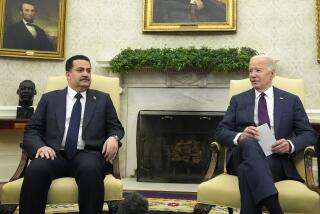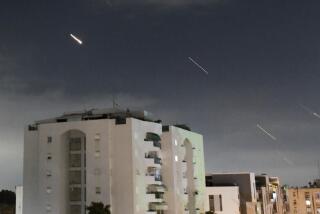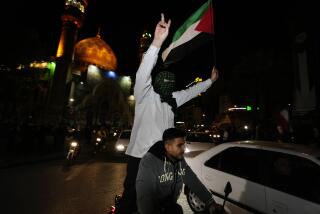U.S. Jets Fired On From Iraq, Officials Say
WASHINGTON — Iraqi ground forces fired at four U.S. fighter planes patrolling the northern “no-fly” zone Friday, American officials said, ending a two-month cease-fire and presenting President Clinton with his first visible challenge from Baghdad since just after he took office.
The Pentagon said the U.S. jets--three F-16 Falcons and an F-4G Wild Weasel--dropped four cluster bombs on the antiaircraft artillery site and returned safely--and apparently undamaged--to Incirlik Air Base in Turkey. No assessment of the damage to the Iraqi battery was available.
Iraq denied that it had opened fire on the U.S. jets.
It was not immediately clear whether the incident, which marked Baghdad’s first hostile action against Western aircraft since Feb. 3, was an aberration or was intended to signal an end to the cease-fire that Iraqi President Saddam Hussein proclaimed in January.
Iraqi radio, which reported that one Iraqi soldier was wounded by the bombing, quoted an Iraqi Foreign Ministry official as branding the U.S. action “aggressive and provocative behavior.”
The Clinton Administration sought to minimize the significance of the incident, indicating that the United States would wait to assess the meaning of the Iraqi action.
State Department spokesman Richard Boucher said Friday that the latest incident “underscores Iraq’s continued failure to abide by” U.N. resolutions on the Gulf War cease-fire settlement and said that Baghdad would be held “solely responsible” for its refusal to comply.
But senior U.S. strategists indicated privately that the Administration does not plan to retaliate further or seek additional U.N. sanctions unless the attacks continue.
Clinton, in Little Rock, Ark., to attend a memorial service for his father-in-law, Hugh Rodham, who died Wednesday, received a detailed briefing by telephone from his top national security advisers.
Private analysts shared the Administration’s view. Jeffrey Record, a military expert, said that it is still “a little early to tell” whether the incident marked a change in Baghdad’s policy toward Washington.
“My suspicion is, this is not the start of anything,” he said.
The incident came a little more than a week after Secretary of State Warren Christopher told reporters that he saw no way in which Iraq could fully comply with postwar U.N. requirements as long as Saddam Hussein remains in power.
Earlier, the Administration had been trying to “depersonalize” the U.S. dispute with Iraq by softening the George Bush Administration’s earlier assertions that Hussein must be removed before the West can restore normal relations with Baghdad.
Since then, Clinton has been attempting to take a middle road, insisting that Iraq must comply fully with U.N. cease-fire requirements but stopping short of criticizing the Iraqi president openly. At the same time, Hussein has held his fire, hoping for better treatment by the West.
Boucher said Friday that the United States and its coalition partners “remain determined to enforce all relevant U.N. Security Council resolutions and the various measures that were enacted to enforce them, including the two no-fly zones.
“Iraq understands clearly what its obligations are in regard to the no-fly zone and will be held solely responsible for the serious consequences of failure to comply,” he told reporters at a briefing.
Friday’s incident occurred at 1:05 p.m. Iraqi time at a place two miles east of the Saddam Dam, which is about 20 miles northwest of Mosul, the major city in the northern no-fly zone.
U.S. officials said that the American fighters were “illuminated” by Iraqi antiaircraft tracking radar, which by itself would have been grounds for U.S. retaliation during the Bush Administration.
The no-fly zone covers that part of Iraq above the 36th Parallel. It was established in 1991 in an effort by Western allies to protect Kurdish tribesmen whom the Iraqis were bombing and strafing. A similar no-fly zone was established last August over southern Iraq, to protect Shiite Muslim marsh dwellers.
Iraqi jets began violating both no-fly zones last fall and on Dec. 27, a U.S. F-16 shot down an Iraqi MIG-25 fighter after it crossed the boundary of the northern no-fly zone.
In the final days of the Bush Administration in January, U.S. planes attacked antiaircraft batteries in both northern and southern no-fly zones in response to Iraqi firing at or tracking of U.S. planes. And cruise missiles were launched at a nuclear fabricating plant near Baghdad on Jan. 17 in an effort to force compliance with U.N. resolutions.
Hussein declared his “goodwill” cease-fire Jan. 19 on the eve of Clinton’s Inauguration.
The last time Iraq fired on a Western aircraft was Feb. 3, when Iraqi antiaircraft batteries shot at two French F-1 Mirage reconnaissance jets. Both French planes returned safely to their bases.
Since then, Iraq has kept its antiaircraft batteries in check but has balked at complying with U.N. demands that it allow international weapons inspection teams full access to nuclear weapons production facilities.
More to Read
Sign up for Essential California
The most important California stories and recommendations in your inbox every morning.
You may occasionally receive promotional content from the Los Angeles Times.










